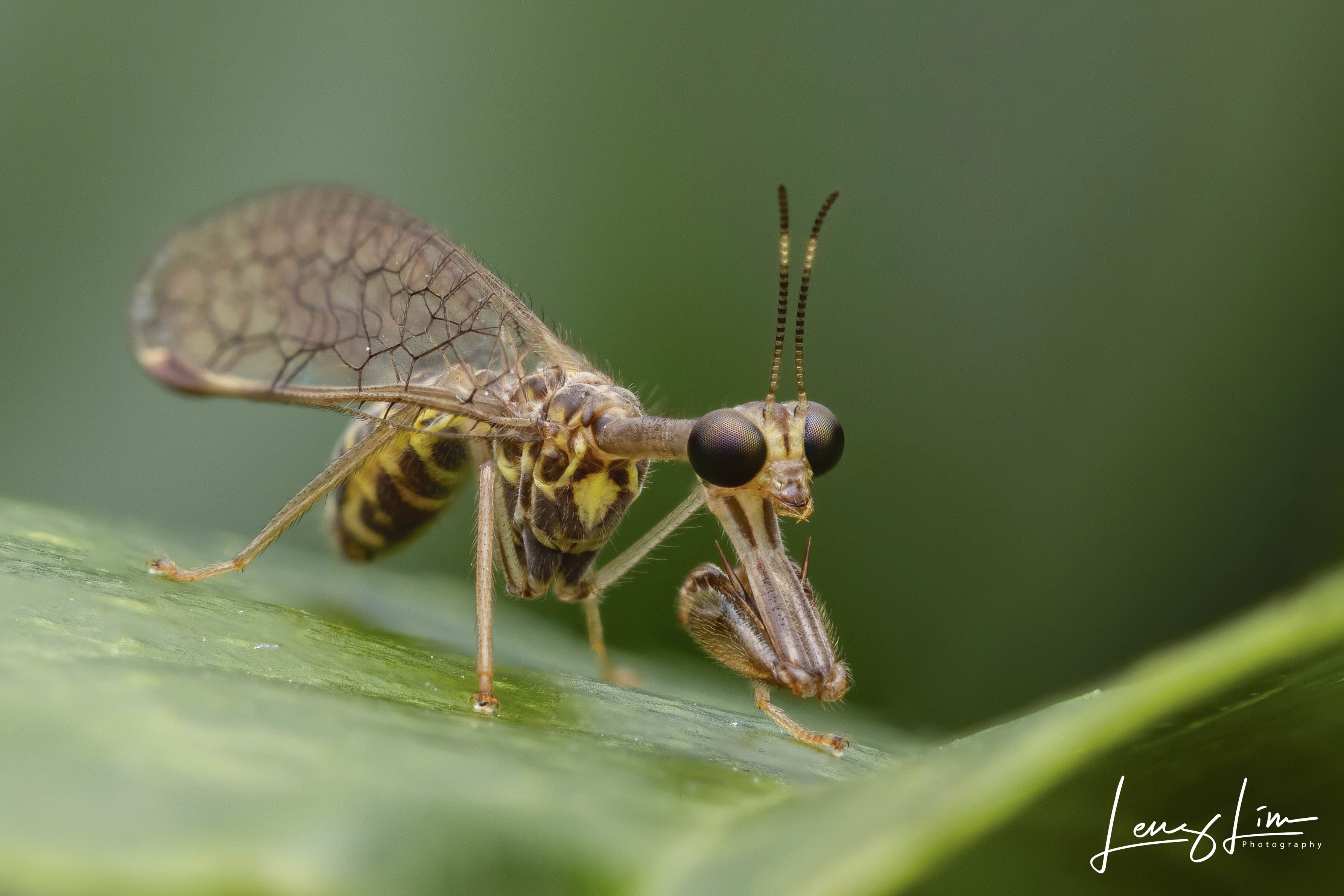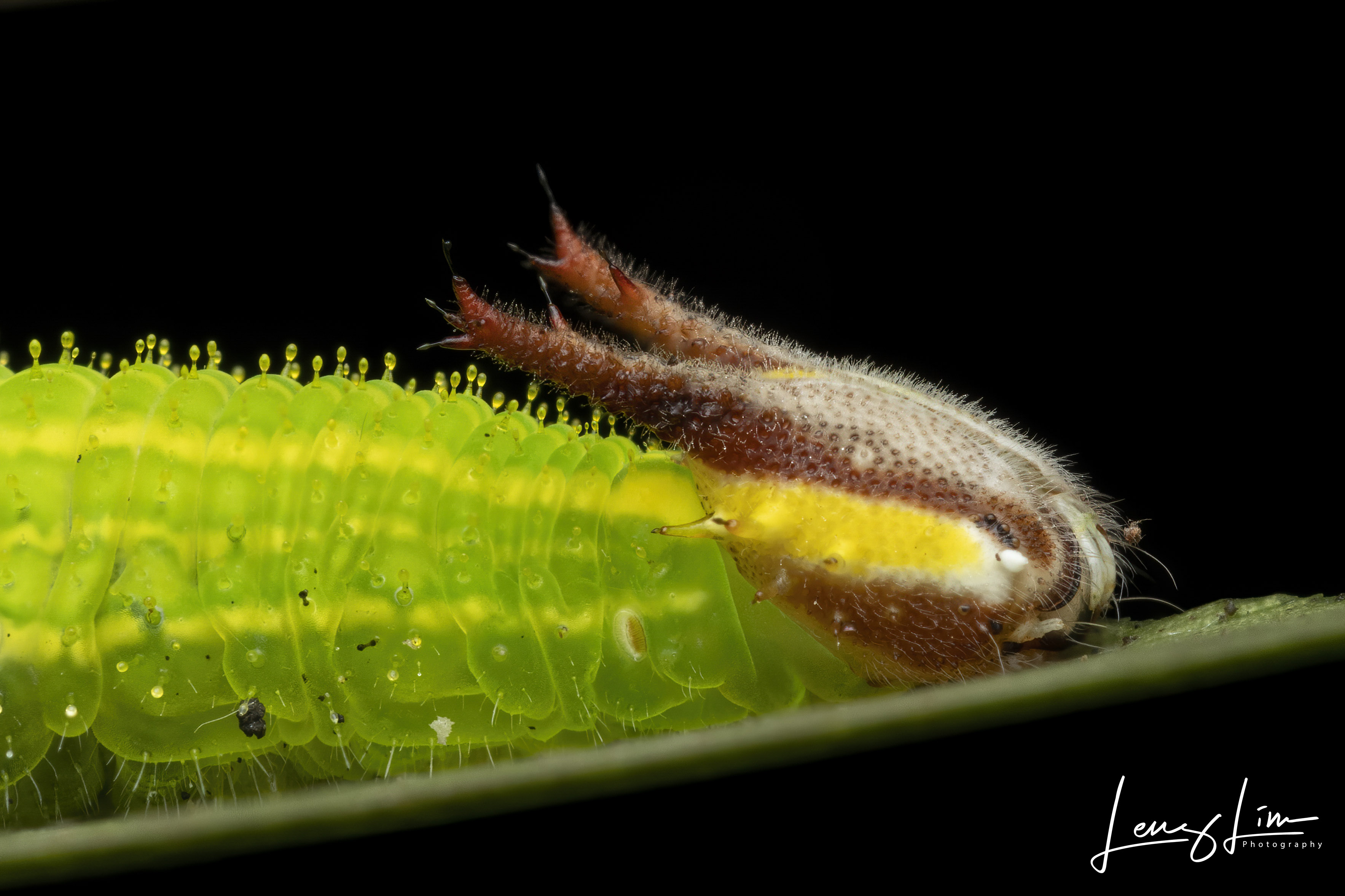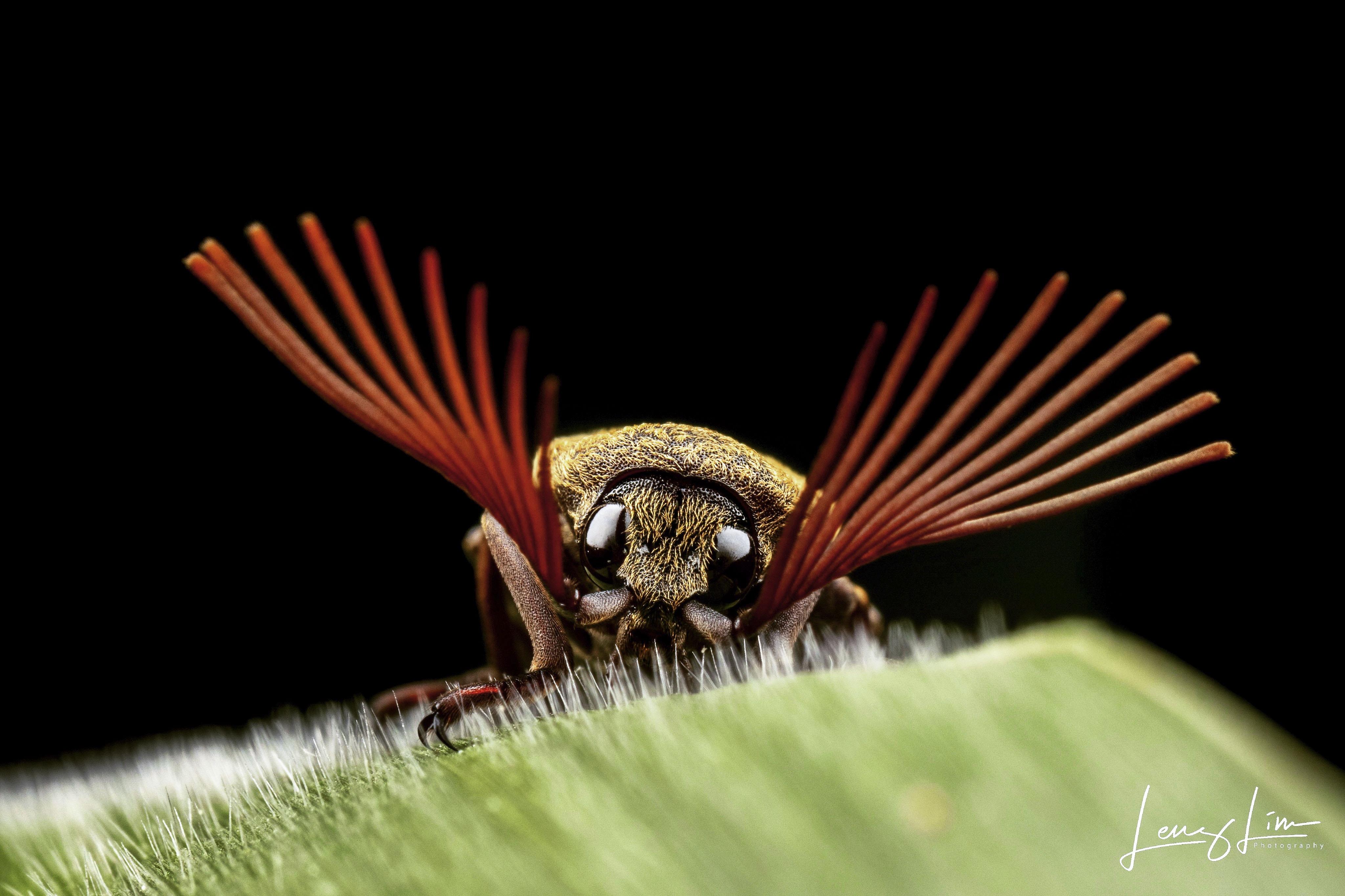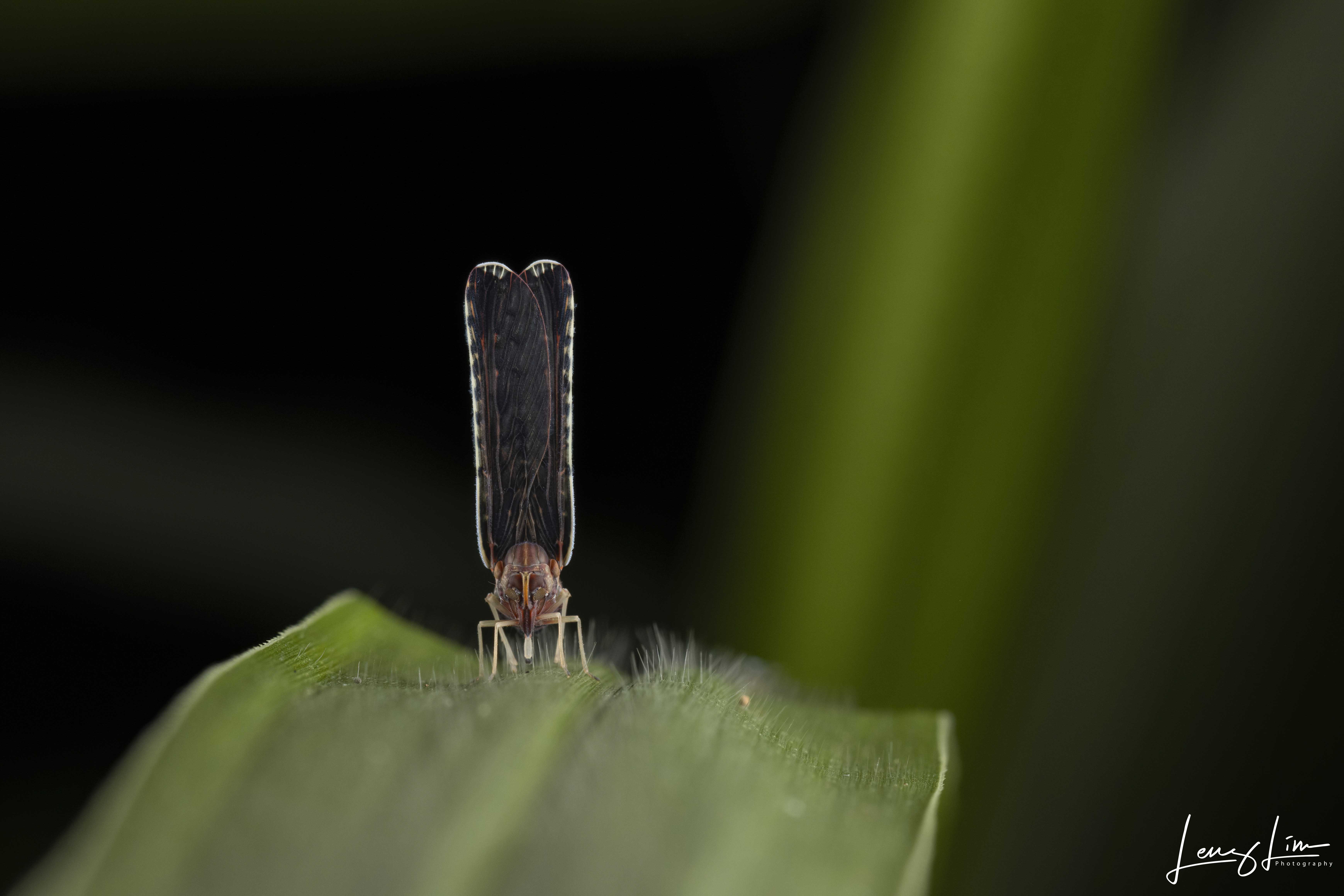
Mantidfly (Mantispidae)
EOS 90D + EF 100mm f/2.8L Macro IS USM
1/160s, ISO 100, f/10 (Stacked)
If you are a photographer who captures any high speed action (wildlife or sports) and are a die-hard Canon fan, you were probably stuck with choosing between the flagship APSC EOS 7Dmkii and the flagship full-frame EOS 1Dxii/iii. Both of these cameras are equiped with superior autofocusing systems as well as fast buffers and are able to capture at least 10fps. The thing is, the former is full of old technology (released 2014) and poor low light performance, the latter, costs a bomb and probably not suited for the hobbyist or struggling student. It was a really, really long wait, but finally, the EOS 90D fills in that gap.
My primary DSLRs are the 7Dmkii and 80D, both of them have their pros and cons, which is why I use them separately for wildlife and macro photography respectively. This time round, Canon merged the best features (mostly) of the two into one sleek DSLR body.
Detailed technical specifications of the camera are beyond the scope of this article (there are tons of review sites who will do that for you), but instead I will show you some sample images and share some thoughts about the camera from a user’s perspective.
Disclaimer: Locations would not be disclosed to protect the arthropods from poaching.

Ladybird Mimic Spider (Paraplectana sp)
EOS 90D + EF 100mm f/2.8L Macro IS USM
1/160s, ISO 100, f/10
The 90D is a semi-professional camera and as the successor of the popular 80D, you can expect improvements. Coming in 30g lighter and just a tad thinner than the 80D, you probably won’t feel a significant difference but what’s new this time is the aluminum alloy and polycarbonate resin with glass fiber used to craft the camera body. Basically the same touch and feel as the new R bodies.

Zitting cisticola (Cisticola juncidis)
EOS 90D + EF 100-400mm f/4.5-5.6L IS II USM
1/640s, ISO 125, f/5.6
Skipping past a few minor tweaks (button rearrangement and mode dial), the biggest improvement comes from the inclusion of the joystick. Generally found in the more professional bodies like the 7Dii and the 5Dmkiv, the 8-direction joystick control makes handling such as quick selection of autofocus points much easier. A definite plus for wildlife shooters. Unfortunately the joystick and multi-controller are not customisable and serve the exact same functions.
The 90D is the highest resolution APS-C DSLR to date boasting 32.5MP and supported by the DIGIC 8 image processor. As a comparison, its predecessor (the 80D) has a 24MP sensor powered by the DIGIC 6 image processor. If cropping your images are essential (as majority of wildlife and macro shooters require), this camera gives you enough pixel density to maintain sharp, detailed images post-crop.
That being said, with 32.5 million pixels crammed into a cropped-sensor, you can expect a certain amount of noise in your images at certain ISO settings as compared with sensors with larger pixels.

Blue-winged Leafbird (Chloropsis cochinchinensis)
EOS 90D + EF 100-400mm f/4.5-5.6L IS II USM
1/500s, ISO 640, f/5.6
The 90D has the same 45 cross-type autofocus (AF) points as the 80D, albeit the hopes of many for more AF points to cover a larger area in the optical view finder (OVF). However, Canon included its famed Dual Pixel CMOS AF system which allows over 5000 selectable AF points which provides almost full coverage across the sensor during live view shooting. Thus giving more compositional freedom.
Face detection also works when using the OVF, a feature that is hardly seen in DSLR cameras, no animal eye AF here of course.
Another exciting feature is the ability to shoot 10 frames per second (fps) despite the 32.5MP and the single DIGIC 8 processor. This places the 90D at the same level of the 7D mkii and faster than the 80D which shoots only 7fps. More fps would mean more chances to capture every bit of action you are seeing. However, the camera’s buffer capacity simply cannot keep up with the higher resolution images and speed at 10fps, so you can expect to take lesser images in a continuous burst as compared to both the 80D and 7Dmkii.
*Note that shooting with the Live View can grant you 11fps using AI focus (great for static subjects) but only 7fps when using AI servo.

Bagworm Moth Caterpillar (Psychidae)
EOS 90D + EF 100mm f/2.8L Macro IS USM
1/100s, ISO 100, f/10
What about the autofocus performance under low light? I tested the AF performance of the 90D during my usual macro shoots and the camera had no issue with focus breathing and acquired the subject quickly (single point spot AF + AI servo was used). This is despite the slow AF of the old 100mm L macro lens.

Palmfly Caterpillar (Elymnias hypermnestra)
EOS 90D + EF 100mm f/2.8L Macro IS USM
1/160s, ISO 100, f/10
Needless to say, the optical view finders on DSLRs produce zero lag and what you see is what you get. So I switched up the camera to live view and noticed minimal lag and accurate metering on the screen. Having an articulating screen is a must have for macro work when the need to shoot at unconventional angles arises. Some older cameras like the 7Dii have rather dimmed screens when shooting in live view which is horrible especially when you can’t even see if your subject is in focus or not.

Argiope sp.
EOS 90D + EF 100mm f/2.8L Macro IS USM
1/125s, ISO 100, f/10
Lets talk image quality. The CR3 RAW files that the 90D produces is the best I’ve seen in the entire APSC line up (the sensor is similar to the one found in the new EOS M6 mk ii). The dynamic range of the 90D has definitely seen a large improvement over its predecessor. I found myself being able to extract more detail in the blown out highlights and underexposed shadows on some images, making them usable again. When I took the shot above, I never had the intention of exposing the web surrounding the stabilimenta (that intricate decorative web the spider was on) and it was originally underexposed and dark. Regardless, I managed to extract all that detail with minimal colour noise and banding.
If you shoot JPEGs, you can expect really pleasing colours as the camera does the compressions, sharpening and slight colour adjustments for you. However, some fine detail may be lost due to the noise reduction rendered on the JPEG, not an issue if you don’t do large prints.

Bird Dung Spider (Pasilobus sp.)
EOS 90D + EF 100mm f/2.8L Macro IS USM
1/125s, ISO 100, f/10 (Stacked)
Another example of how simple it is to extract detail out of subjects that are darker. Image was stacked to obtain a larger depth-of-field.

Bird-dropping Spider (Cyrtarachne bufo)
EOS 90D + EF 100mm f/2.8L Macro IS USM
1/125s, ISO 100, f/10 (Stacked)
Similar to the EOS RP, the 90D comes with the new focus-bracketing feature to help you focus stack. The experience using this feature is identical to the RP and my thoughts about this feature still remains. I would not recommend using it as it is too much of a hassle to set up a tripod and your subject has to be completely compliant. Doing this in the field would result in tons of lost images. Handheld stacking would be more effective and efficient. Moreover, the feature will only work with lenses that have autofocus.

Dead-leaf Mantis (Deroplatys desiccata)
EOS 90D + EF 100mm f/2.8L Macro IS USM
1/125s, ISO 100, f/10
Battery life is just as what you would expect from a Canon DSLR. You pretty much can shoot all day on a single charge. In terms of power management given all the new technology, the 90D can actually sustain more shots on a single charge compared to both the 80D and the 7Dmkii.

Cedar Beetle (Callirhipis cardwellensis)
EOS 90D + EF 100mm f/2.8L Macro IS USM
1/100s, ISO 100, f/11
There really isn’t much to dislike about the camera considering the 90D is in fact a large upgrade from the 80D. From amateurs to semi-professionals who are looking for a versatile, powerful all-rounder body that can utilise both EF and EF-S lenses, this is the camera for you. I have not even touched on all the other pro-grade features and the video capabilities that the camera provides. At its price point, it brings much value to the table.
In conclusion, the 90D is a camera for enthusiasts who are still not ready to embrace the mirrorless revolution and one that can get the job in almost any situation. I’m impressed with everything the camera can acheive but it would have been more of a hit if it was released 2-3 years ago. The EOS 7Dii still reigns as the flagship in the APSC lineup but with the new technology and features the 90D provides, I would definitely choose the 90D.
Feel free to contact me if you have any questions / comments.
More sample images below and on my Instagram page.

Trilobite Larva (Platerodrilus sp.)
EOS 90D + EF 100mm f/2.8L Macro IS USM
1/160s, ISO 100, f/10 (Stacked)

Derbid Planthopper (Derbidae)
EOS 90D + EF 100mm f/2.8L Macro IS USM
1/125s, ISO 100, f/10 (Stacked)

Moth-like Planthopper (Ricaniidae)
EOS 90D + EF 100mm f/2.8L Macro IS USM
1/100s, ISO 100, f/11



I love your work! Your reviews are very informative, I do have a question for you though since it looks like you have experience with the two cameras that I’m debating with. I currently shoot with the canon 80D, but I am considering upgrading soon and it’s hard to decide between which direction to go. I’ve been considering between the canon 90d and the eos R. The 90D makes more sense since I have EF and Ef-s lenses and I enjoy the extra reach. On the other hand I worry that I’ll loose out on Full frame features such as improved low light functions, if I don’t go with the Eos R. I find that the canon 80d is difficult to manage under low light shooting and being that the 90D is also a cropped sensor I worry that the improvement will not be enough. The 90d however would give me the benefit of the extra reach since I don’t see myself buying a 500 or 600mm lens any time soon ( I use the canon 100-400 ii). Given that I mainly shoot wildlife and landscapes which of the two systems would you recommend? Thanks for taking the time to go over my questions, for reference to my work feel free to check out my IG@ alvarado_dan_
Keep up the great work!
LikeLike
Hi Daniel,
Thank you for dropping by and for the question. It is not one that is easily answered. Let me address your concerns one by one.
You will be able to use your EF lenses on any R system with the EF-RF adaptor without a drop in image quality and performance. It is a seamless transition which is a huge selling point. EF-S won’t work well as they are meant for APSC sensors and you will experience vignetting.
In terms of reach, you can always shoot in 1.6x apsc crop mode, the 30.3 mp full frame sensor in the EOS R will give you significant cropping power unless you intend to do large prints. Of course 32.5 mp on a APSC will grant you even more pixel density and cropping power.
Low light performance of the 90D compared to the 80D isn’t that much of a improvement because the sensor is packed with megapixels so the full frame sensors will perform much much better. This will help a lot for landscape work too.
I also did a review on the eos r wildlife photography so you may want to check that out.
My honest opinion is that if wildlife is your primary genre of photography, go for the EOS R5/R6 which have AF systems that are unparalleled and have the fast FPS that wildlife shooters need. I personally sold off both my 7Dii and 80D for the R6. The EOS R is just like a 5Dmkiv, the R6 is a 1Dxiii. They will work with your EF lenses too but if you want more cropping power and “reach” then the R5 is perfect albeit the cost. I would not use the EOS R for wildlife due to the inferior AF and FPS that the successors have brought to the table. The 90D is versatile and is a fantastic camera but 7 FPS isn’t enticing especially with the technology we have today.
I hope I helped you in your decision making. Ask away if you have other questions, you may send me a DM on Instagram @thru_de_lenz too.
Thank you!
LikeLike
My apologies for the the typo on my previous reply. The 90D is able to shoot 10fps* not 7fps*
LikeLike
I gave up on the 90d. I shoot mainly small birds mostly with Ef 500 ii I love the crop sensor providing 800mm field of view & f4. Excellent image quality with terrific cropping room. Nice 10fps & ok buffer. But I could not get consistent sharp focus, I was getting 1 of 10 in ok focus maybe 1 in 20-30 sharp. I went back to my old 5d4 & extender getting poorer cropping room but getting 1/2 shots In sharp focus. Now shooting R5 getting 8-9 of 10 in very sharp focus. I like the 90D in all respects except auto focus.
LikeLike
Yup, with a 83.2mp pixel density on a full frame equivalent sensor, the 90D truly extracts any detail you can possibly want, one of the best features of the camera. I’m sorry to hear about your unit, I personally had no problems with AF with the one I did the review on. Could it be an issue where AF micro adjustments are needed to get the lens and body working well? If not, your unit may very well be a defective one, you should not have any AF issues. Either ways, glad that you upgraded to the flagship mirrorless systems, they work wonders!
LikeLike
Hi!
Thank you for the very informative review.
I have recently purchased the Canon 90D after using the entry level 2000D for some years. Photography was mainly a hobby and I spent majority of my time focusing on landscapes. Recently however, I had people contact me regarding wedding/ portrait shoots and I have done a few with decent results. But, I feel I lost lots of what could have been amazing pictures because of lack of focus and using a not so great lens.
I currently have the 50mm 1.8 STM lens and a Tokina 11-16mm Lens. My question is, I’d love to cover macro shots as well? Which lens could you recommend? And with the lens I have available would i be able to cover weddings and portrait shoots?
Regards,
Riyaad
LikeLike
Hi Riyaad,
Thank you for your message.
I have actually owned both the 50mm 1.8 as well as the tokina 11-16 2.8 before and here are some of my thoughts. I’m not surprised that your images would be a tad soft or “out of focus” when using the 50mm especially wide open at f1.8. It is a budget lens for a good reason. It is not easy getting a tack sharp image even if u stop down your aperture. The 11-16 tokina ultra wide is fantastic for APSC cameras and ultra sharp too. In fact it is better than canons ultra wide lenses for APSC cameras. You shouldn’t have a problem with this lens albeit the obvious distortions at the corners.
If you are intending to do portraits with the 90D and are on a tighter budget. I urge you to give the 40mm f2.8 pancake lens a shot. It’s the cheapest and sharpest portrait lens with fantastic bokeh. I have used them for events, even on my EOS R5 till this day. If budget is not an issue, of cause the 50mm f1.2 or 85mm L lenses will do the job. For weddings, having a telephoto zoom like the 70-200 would be great for tight close ups and candids but you do need something in the 24-70 range for wider group shots etc. If you are the only photographer around, it’s easy to miss the moments if you are fumbling to change lenses, best to shoot with two bodies.
If you want to do macro, definitely get the EF 100mm f2.8L IS USM lens. It is inexpensive and tact sharp, however autofocus is slow (it’s a really old lens). It is the best choice as u are still on the DSLR system. You may use it for portraits too but on an APSC, 160mm is pretty overkill.
Let me know if you have any other questions!
LikeLike
Thank you for the thorough response. Would you recommend the 40mm over the 50mm with regards to portraiture?
Also, with regards to the Macro 100mm Lens, the EFS 100MM USM is double the price of the NON-USM version. It is quite pricey. Would it make a huge difference if I was to opt for the non-usm version, or should I lean towards the 60mm Macro instead?
I have also started a food blog and have a mini photo studio set up. Are there any lens you mentioned that would work in a scene like that?
Thank you for your feedback, I do appreciate it.
LikeLike
With a APSC camera like the 90D, shooting at 40mm is a 64mm equivalent on FF. The compression is good enough for portraiture too. I would only choose the 50mm if budget is not a concern as mentioned, of course it is ideal but the 40mm
pancake is a tiny, powerful and value-for-money lens.
I believe you mean EF 100MM, there is no EFS 100mm. Yes the EF 100mm f2.8 L IS USM is worth every penny if you are sticking to the EF mounts. 100mm is easier to work with as you with have a more manageable working distance to your subject and essentially allows you to get “closer”. 60mm is used for wider scenes or for larger subjects.
If you are venturing into food photography and studio set ups, the 100mm would be a bit hard to handle as u are shooting at 160mm for equivalent. So choose a wider lens for that. If you are talking about macro in a studio set up then of course the 100mm will do its job.
LikeLike
Hi Lenz,
I am a student who primarily shoots wildlife, nature, and macro on a Canon 1D mark IV (old but excellent). I would like a modern body for travel, macro, and landscape. My options in my price range are the 90D and the RP. Both are the same price at my local camera shop. The 90D looks like the more mature camera and may be an improvement on my 1D mark IV even for wildlife. But the EVF and sleek RP are attractive and I realize mirrorless is where I will shift to eventually. Which would you recommend (my macro lens is Laowa 100 2x and I own ef 40 2.8).
I appreciate your help and I really enjoy your cedar beetle shot.
LikeLike
Hi Jay, thank you for your question. It isn’t easy choosing between the 90D and RP. You have to really decide if you want to move to the mirrorless system (which you should as all new tech will on mirrorless systems). In terms of shooting nature and you want to stick to DSLRs, the 90D would definitely be the better bet if you are comparing it with the RP. In terms of megapixels, fps etc. The RP is not meant to shoot fast action, it’s more like an inexpensive transit to full frame mirrorless. If you want to go mirrorless to shoot wildlife, the R6,5 and 3 are your best bets.
LikeLike
Shooting with a full frame mirrorless would make handling a fully manual lens like the laowa 100mm a breeze. Using the adaptor wouldn’t drop your image quality and performance too. However take note you will get higher pixel density using the 90D, resulting in wayyy more cropping power.
LikeLike